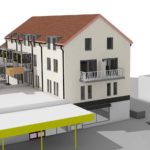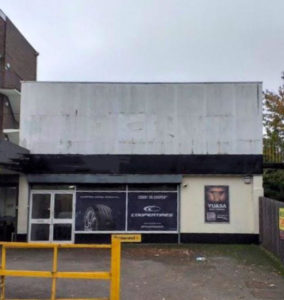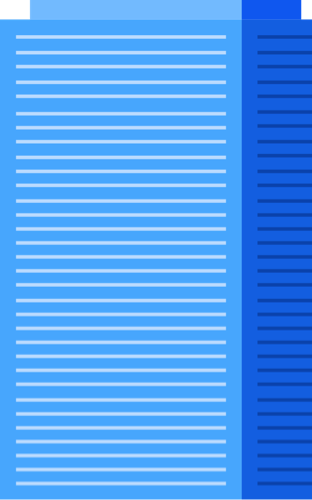CurveBlock Blog
CurveBlock is thrilled to announce a significant milestone in our journey with the commencement of Project Cononley in Yorkshire. This strategic joint venture is in collaboration with our existing Angel Investors. Full planning permission for the development of the site to provide 25 bespoke new homes, with construction works set to commence work in the first quarter of 2024. Six of these homes have already been reserved off-plan before any marketing has taken place, underscoring the project’s exceptional promise and market confidence.
We are excited to be implementing a dual-branding strategy for the site, which fits with our commitment to enhancing the visibility and trust of our innovative practices. This dual branding approach not only serves to elevate CurveBlocks profile in the market but also starts to take our viewers on a journey through the construction process. It is goal to educate our followers on the complexities of building bespoke homes and showcasing the
synergies between quality craftsmanship and innovative construction methodologies.
Upcoming in 2024
RoadMap 2024 so far
Q1 Project Cononley Commences
Q1 Golf Sim Number 1 Commences
Q1 Project Cornwall to Exchange and Commences
Q1 Wait-List Onboarded
Q1 Peer-to-Peer Trading Opens
Q1 Digital Security Commences targeting ISO27001
Q2 Digital Securities Sandbox Intake
Q2 Project South East 1 Public Showcasing
Q2 Project Scotland Public Showcasing

On the heels of signing a deal for investment with Loyal VC, a Canadian based venture capital firm, CurveBlock was contacted by representatives of the Canadian government.
After seeing an article announcing the agreement between CurveBlock and Loyal VC, a UK based representative of the Canadian government reached out to CurveBlock to connect. That contact resulted in a video meeting with CurveBlock and three Canadian government representatives. The Canadians were interested in learning about CurveBlocks business model, especially regarding carbon zero and energy positive developments. The Canadian officials were especially interested in homes being constructed with energy positive methods since Canada has recently committed to phasing out coal burning power plants by 2030. This conversation has led CurveBlock to research Canada’s real estate development codes for possible future growth. The effort for more sustainable energy production is an exciting conversation and the idea that homes can contribute energy to the grid instead of using energy from it makes the conversation more interesting. These types of conversations stand to validate the carbon zero and energy positive direction CurveBlock has taken.
CurveBlock is committed to modern methods of construction utilizing modular construction methods that keep costs comparable but decreases time of construction. Using complete engineering schemes owned by CurveBlock, the company has the flexibility of working with a broad range of factories producing modular homes which facilitates scaling production. The kit required to produce the energy positive result is not new technology. However, it is improved with new applications, using current, high preforming components to give CurveBlock the desired positive outcome. With engineering plans from CurveBlock in hand, presumably, any modular factory in the world should be able to produce the same home as another. With the home energy kit design in hand with specific components outlined, installers around the globe will be able to install the needed technology to make any CurveBlock home, anywhere in the world, carbon zero, energy positive to fulfill the CurveBlock mission.
CurveBlock is currently participating in the 5prinG Green Innovation Challenge sponsored by Wayra, O2, Deloitte, Digital Catapult and West Midlands 5G. Through this accelerator, CurveBlock has found new partners and technology to integrate into their energy positive homes. One of the technologies would allow a whole house monitoring system that monitors both production and consumption of energy as well as the ability to diagnose any possible future faults within their homes. The ability to monitor faults in real time using 5G technology would reduce maintenance costs of a CurveBlock home. CurveBlock is also looking to integrate community features like self-sustaining streetlights that will power themselves with both wind and solar. These lights would be deployed in CurveBlock communities and also allow for charging electric bikes, scooters and possibly vehicles and yes, your mobile devices while enjoying the outdoors. The same partner also produces solar powered benches for with the same charging ability.
CurveBlock is committed to bringing the latest technology to our homes and communities that will all work to reduce our individual carbon footprint on the world all while improving each resident’s quality of life. All of these factors working together will allow CurveBlock to meet its goal of having a positive impact on our environment and community.

CurveBlock- Wallington development: The Story so far.
We recently announced first stage approval has been granted. Our involvement in the Wallington development spans 12 months. Below is the history of the site thus far. The challenges faced in UK construction planning approval lend to the incredible potential for profits upon successful completion of this process, IF you have the skill and knowledge necessary to surmount the many hurdles.
Our initial introduction to the site was in November 2018 and was made via the retained marketing agent. After initially deciding that the opportunity was not feasible due to the design and aesthetic of the existing building, a curiosity began to build that there was in fact a real opportunity to turn this horrible building into something worthwhile – both in design and financial terms.
The following 3 months involved the viewing of the building and its surroundings on numerous occasions and a number of meetings with our architects and planners to determine the potential of the existing building and any further potential that it may offer. In early February 2019 we concluded that the building had the ability to be converted under a Prior Approval Notice into 4/5 flats AND had further potential for up to 7 additional flats on the roof and at the side. This led to an offer being made to the retained agents at the advertised asking price and the acquisition being agreed in early March.
Whereas most property TV programs will assure you that this is it, deal done and everything else is plain sailing, unfortunately this was the beginning of the numerous issues we have had to encounter and overcome in the following 11 months.

The property we had agreed to buy was a first-floor office, with ground floor entrance and car park. We had also been advised that we would have the ability to extend the building upwards. The issue we encountered was that the property was held under a ‘flying freehold’[1] which effectively means that it sits atop another freehold title[2]. This is uncommon, but not unheard of in UK property, it did mean that there was legal uncertainty as to which of the freeholds would be ultimately responsible for the structural integrity of the building. Coupled with this was also a legal query as to which of the freehold titles ultimately owned the legal right to extend the building upwards.
At this stage, after spending a considerable sum on legal bills (we had also agreed to cover the vendors legal costs as part of the transaction), we decided that although we could gain planning permission for our intended development, we would have serious concerns as to whether the buyers of the completed units would be able to secure a mortgage. Unfortunately, in late June we decided that it was no longer feasible to
continue.What followed was the realization that we had potentially wasted almost 8 months and had a considerable abortive bill. We had to inform the owners, our design team and finally the marketing agent – firstly to thank them for their assistance and involvement, but ultimately to say we would be unable to progress further.
The conversation with the agent was painful for both sides and is not a conversation anyone enjoys having or having to make that call in the first instance. It is a conversation most would seek to avoid having in person, but would instead deal with via email, text, WhatsApp etc.
If you take one piece of advice from reading this article, please let it be this:
‘No matter how hard the issue, do not avoid it. Confront it, and deal with it head on’.
The conversation with the agent developed rapidly from joint dismay, to exactly how this transaction could be resurrected. Following our lengthy legal advice, the only way this could continue would be to acquire the ground floor freehold in a linked transaction with the flying freehold – the catch? It would mean acquiring two titles from different sellers (with different solicitors) for the same figure we had agreed at the outset. Despite this seeming like an uphill struggle, the conversation with the two freeholders progressed at pace over the following 3-4 weeks and in mid-July we received fresh contracts from both freeholders.
The legal conveyancing started again in earnest and gave us confidence to submit our Permitted Development application (planning application) to the Local Authority in August. Once again, we thought that we had regained control of our own destiny – after all, the statutory period for a planning authority to determine a Permitted Development application is 56 days/ 8 weeks.
What followed was a number of queries from the planning department about various aspects of the scheme. Each query then had a requirement to produce further drawings, amend the existing drawings or to instruct further specialist reports to accompany the application. Whilst we have an extremely diligent professional team around us, each variation to the initial application required the planning department to reconsult the surrounding neighbours and various other Council departments. Although seemingly a straightforward process the statutory period for consultation is 3 weeks, so for every change, the clock reset.
Finally, in January 2020, with all boxes seemingly ticked, the final curveball. The Environmental Health department requested a further acoustic survey be undertaken of a nearby commercial premises. This report was quoted, instructed and carried out within 48 hours of this request, with the accompanying report issued inside 4 days. Following submission of this final report, the Local Authority finally issued the Prior Approval Notice on 13th February. This will allow us to complete on the purchase of both freehold properties in March 2020 and physical works on site to commence in due course.
We have also now been able to submit the formal planning application for the second phase of development.
[1] https://www.lexology.com/library/detail.aspx?g=bb83c467-6a2d-4b74-8504-9feeea3b36f8
[2] ownership of property with the right to pass it on through inheritance.

What CurveBlock has known from the very beginning is everything will eventually be tokenized.
What does “tokenized” mean?
Tokenized means everything will have a digital, trade-able identity in the form of a legally recognized token or digital representation. Today when you buy a car, you are given the paper title of that car to show your ownership. The only difference with a token is that the title is electronic or digital. In other words, a token. Ultimately, this will make for faster and more efficient transactions for everything from buying a home to buying stocks or bonds and yes, even cars. We have not reached this point yet because the token or contract that represents that token, called a smart contract, is still not recognized as law and has yet to be challenged in a court of law. There is a strong argument that supports smart contracts as legally binding under the Electronic Signatures in Global and National Commerce Act (ESIGN Act) and the Uniform Electronic Transactions Act (UETA). While I am no attorney, people that do understand this area of law at the Digital Chamber support this understanding, that smart contracts are already covered and need no additional law and in fact, additional law would only stand to confuse the situation.[1] States need to be encouraged to look to the existing laws instead of confusing the situation and could do so simply be recognizing the existing laws publicly. This would be a big step in adoption.
As of 18 January, Hawaii is looking to take steps towards adoption with a new bill introduced that would both allow banks to hold or custody, your digital tokens and allow the courts to hear digital asset claims (which again is arguable not needed).[2]
While Hawaii would not be the first place to allow banks to hold your digital assets, it would be the first in the US for a purely commercial bank. Wyoming has instituted a law for companies to custody digital assets, but commercial banks would argue these are not the same as banks which is not a discussion for this article. Switzerland on the other hand, is the first to allow a commercial bank to custody digital equity.[3]
Seeing commercial banks entering this digital equity space is exactly what we at CurveBlock saw coming in the beginning. We are now, starting to see the commercial world joining us which will only stand to drive faster and bigger adoption of the technology. All of this adoption and growth will only stand to support and increase the growth of the companies with solid business models in the digital equity space, like CurveBlock.
If you are not familiar with what CurveBlock is doing, we invite you to explore and learn more here on our website.
Joey Jones Co-Founder/Chief Revenue & Compliance Officer
[1] https://digitalchamber.org/policy-positions/smart-contracts/
[2] https://finance.yahoo.com/news/hawaiian-bill-let-banks-act-210021041.html
[3] https://www.coindesk.com/swiss-banks-enter-the-age-of-bitcoin






















